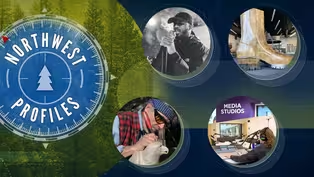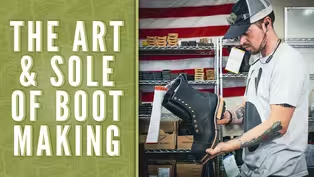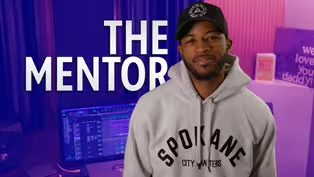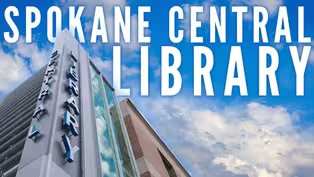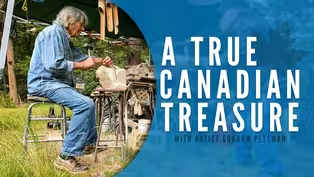Northwest Profiles
February 2023
Season 36 Episode 4 | 26m 51sVideo has Closed Captions
BC artist Graham Pettman, music producer T.S The Solution, Nick's Boots & Library Renewal.
We visit Graham Pettman at his studio in British Columbia; see what motivates music producer and Hip Hop performer Devonte Pearson a.k.a T.S the Solution; Meet the talented folks that make hard-working footwear at Nick's Handmade Boots; and see the exciting changes the Spokane's Central Library, where you can check out a book or book a music studio!
Problems playing video? | Closed Captioning Feedback
Problems playing video? | Closed Captioning Feedback
Northwest Profiles is a local public television program presented by KSPS PBS
Funding for Northwest Profiles is provided by Idaho Central Credit Union, with additional funding from the Friends of KSPS.
Northwest Profiles
February 2023
Season 36 Episode 4 | 26m 51sVideo has Closed Captions
We visit Graham Pettman at his studio in British Columbia; see what motivates music producer and Hip Hop performer Devonte Pearson a.k.a T.S the Solution; Meet the talented folks that make hard-working footwear at Nick's Handmade Boots; and see the exciting changes the Spokane's Central Library, where you can check out a book or book a music studio!
Problems playing video? | Closed Captioning Feedback
How to Watch Northwest Profiles
Northwest Profiles is available to stream on pbs.org and the free PBS App, available on iPhone, Apple TV, Android TV, Android smartphones, Amazon Fire TV, Amazon Fire Tablet, Roku, Samsung Smart TV, and Vizio.
Providing Support for PBS.org
Learn Moreabout PBS online sponsorship♪ Hello and welcome to Northwest P I'm your host, Lynn Veltrie.
And although winter is finally s to wind down a bit, it's still cold enough to enjoy cozy fire or blanket while you s in to enjoy another round of sto on this edition of Northwest Pro Just ahead, three of our four pr will illuminate artistry in moti through the work of skilled crea including a native Canadian arti whose work is a blend of his Cre and British roots.
And from Spokane, an up and coming musician who uses the to inspire change and to gifted who enjoy the art and soul of bo As for our final story, we'll pay a visit to the library in this case, Spokane's newly renovated centra which, as you'll discover, is a library far from the ordina So with all that and more teed u ready to fly, let's get rolling, For our first story, we head north to the Cariboo reg of central British Columbia to meet a native artist who has years exploring and expressing his complicated cultural identit Chipping Rock Chipping away... pieces of material, from a nondescript piece of soap stone.
In some respects, this is part and parcel of what artist Graham Pettman's existence is, creating art that has meaning...that goes deep into what makes him tick.
Graham has been carving and creating eye catching pieces for many years, pieces that convey the connection between the earth, nature, and art.
Now based out of 100-mile house in the Cariboo region in Central British Columbia, Graham celebrates his heritage with his paintings, drawings and carvings and revels in an art form that in many respects he helped propel into today's Plains art style.
Born and raised around Fort Vermillion in northern Alberta, life was hard for Graham when he was young.
My mother was pretty well a full-blooded Cree.
My dad came here with the fur trade in the twenties.
So that's where he met my mother I grew up in an era which was the war years.
My father went being Brit, he went to the Air Force.
He was a pilot.
My father left basically what happened at an early age, So I was stuck up north with just relatives that already had too many children in little Log Shack sleeping on the floor you know.
From the impressionable years of 7 through 10 Graham was shipped off to the St. Augustine's Smoky River residential school for native children in Peace River Alberta.
That's that was kind of a downer in most sense.
It was, but in a sense, I had bed and three meals I'll tell you when I was there, I must have been about eight years old.
It was springtime and everything was melting.
And that was where boys were out playing in the little puddles, and we'd make little canals in between the puddles.
And I found a piece of bark and I was using that.
And I thought I bet I can make a little boat out of that.
I used my teeth, and I made a little boat.
I used that.
That's probably the first example of carving.
There you go.
I emulated the beaver (laughs) I grew up native, basically the Cree side.
I knew the language then but have since forgotten it.
And my grandfather was a Indian doctor called him a shaman So I was privy to that, but I didn't follow in that line.
I thought I'd do the supernatural part.
I guess you could call it healing.
A better word, through art, and that's what I try to convey.
One of the things in there my paintings, the imagery, the connection between nature and flora and fauna, things that grow.
I put try to put that in the paintings and in the sculpture, the connection between the earth and us.
It's my identity.
You know, who I am because it's been hard growing up, being on the fence.
You know, I have cousins that are pure Cree, and I grew up being getting razzed by them.
And throughout, I was in the Army at a time when racism was pretty rampant.
what I am both sides of the of my background, that there is identity there, I'm trying to prove it.
Graham, along with his younger brother Clifford, trapsed through the BC art scene in the early 1980s when an Inuit friend turned them on to soapstone carving in Vancouver helping, he and Clifford and a few other artists develop their plains art style.
He was a natural artist, and I went to art school, but he didn't really have to.
He just a raw talent.
He took it up real fast.
Anyway, he was selling things in the galleries in Victoria, and he was telling me, he says you've got to do this brother.
So, it didn't take me long.
I got some soapstone and this is about 80, 81 so through the years we did quite well Unfortunately, he died 4 years ago.
Anyone who does creative things, you just know when you're in your form and you've nailed it, I guess athletes feel that too, or anyone, you know, you just said, damn, I got it.
Maybe like Thomas Edison, Eureka, I got the light bulb.
Oh, that's quite a there's some paintings and sculptures that just work out After working with granite and marble, it's almost child's play.
But it's not the medium it's what you do with it, right?
It means it means my whole being.
I think, you know, you just have to be doing something that means something that's meaningful.
I don't know how many years I got left or a month to going to make the best of it and stay positive and value every minute.
84 winters, you know, you learn stuff, you know, when you're young, you're so busy running around making a living.
You're looking at things, you reach an age where you see, you start to see.
just see beyond the obvious.
Graham refers to himself as a fe sitter balancing between his native and British h Fortunately for those of us who enjoy his work, there's no question he has found his artistic footho On the way next, we pivot from artistic expressio through clay to that found in so And for that, we return to Spoka to meet the musical artist known as T.S., which is short for The Solution.
His given name is Devonte Pearso a rising star in Spokane's music who uses his gift of musical cre to mentor young people and inspire change in his commun Hello, my name is Devonte Pearson.
I go by T.S The Solution.
I'm a hip-hop artist, audio engineer, lead engineer, at Panoramic Dreams Recording.
Musical influences, most of it comes from introspective artists that try to paint this picture of how they go through life, internally and present it to us in a consumable manner.
The music didn't expose the problem it solved the problem for me.
And I think that's what conscious rap does for me.
For sure.
It solves the problem.
I grew up mostly in Kent, Washington.
I was born in Long Beach, California.
Parents moved up to Washington when I was fairly young.
There wasn't stability around like family-wise.
Didn't really take school too seriously.
My older cousin Calvin, I wanted to do everything he did, whether it was good or bad.
The good side was the music, but it was also a gang culture that he was involved in too.
Good and bad, that's like my role model.
That man means a lot to me for sure.
I was in Moses Lake when I was 17, 18 years old, and I was there for a Job Corps.
It gave me stability.
It gave me structure, something I needed as a kid I didn't know I needed at the time.
I got to learn how to use tools and a trade under my belt.
It just taught us a way of life that what?
It took us a lot longer to figure out.
But from there, that's where I met my wife and go out to the West Side.
We lived in Renton and she she found out she was pregnant with twins!
Like colony?
That's one of your spelling words?
C, O, L, O, N, Y Remember when we used to work on these?
When we're at home doing school.
You can choose which page Yeah baby, I just want you to knock out one page per day Thats disgusting What does it say?
Flies can taste with their feet That's gross.
I didn't know that we came to Spokane because I wanted to take the audio engineering program at Spokane Falls Community College.
I got involved with doing shows while I was at school.
There's this one venue in town that everybody said, You have to do this one.
This is the best venue in town.
And it was called the Bartlett.
They present in multiple opportunities to me.
They put me on stage so they got us involved in the community a ton.
Currently, we're on the board of Sparks Central dealing with the youth and getting them involved in creative activities.
We did a mixtape camp with the kids, taught on Garage Band, beat production and got to see how involved kids are and how serious they take production.
Most of it has been music based, wanting to teach everything that we know of.
We've held creative writing workshops.
My wife and I, we don't work the 9 to 5 hours.
We work all day in and then we make time for family time.
They have a chore that they usually do at home if we're at home.
But if we're here, they still have chores like the kids.
Help me with the building.
They take care of the building with me.
It's one thing for me to tell you to chase your dreams and follow your dreams.
And for me to sit there and not do it is like.
Kids are smart.
They.
They understand.
Like, something doesn't make sense here.
So in order for me to sit there and tell them to chase their dreams, I have to chase mine and they have to see it.
Mentorship is can change the dynamic for lives so, so much.
When I think of my cousin, I think of mentorship.
I think of man, if I didn't have somebody so close to me, I don't know how I would have gotten so far.
It's hard to put in words but I love what I do.
I know the importance of it.
I know this is the type of stuff that makes the world go round.
I know this can change somebody's life because you make something out of nothing.
Completely nothing.
And it's like, Wow.
At the end of it all, we can have an album or we can have a song.
I've watched hip hop.
Rap music change so many people's lives for the better.
Let's create something out of nothing and just change the world.
I need to stress that our next story is not about Traditionally, a cobbler is someone who repairs However, the artisans we highlight next are Cordwainer which is the correct term for bo makers and Nics Handmade boots Valley, boots of all kinds are designed and built from raw [Jamin Lau] When I tell my friends, I make boots.
They're like, okay, cool.
How much do they cost?
And then I tell them, the price tag, Oh, six, 700 bucks.
And they think, Who the hell pays six or 700 bucks for a pair of boots?
[Steve Mowe] So, the company started in 1964, and there had been three other owners prior to me, and I bought it in 2013.
It basically was a boot shop and I always thought boot makers were cobblers, but cobblers are sort of shoe repair people and cordwainers are boot makers.
[Michael Hunter] It's a kind of an old world trade.
It was something that families did.
They passed this trade on to the next generation because everybody wears shoes.
[Shuyler Mowe] We probably make things less efficiently and with less automation than were made like 100 years ago.
And so that's really the advantage on like, on a qualitative standpoint that you get with having that handmade component.
Is you can use leather that's a little bit thicker.
You can use midsoles that are a little bit thicker, you can use soles that are a little bit thicker.
And so you do get, you know, a much more robust product.
Of course, at a commensurately higher cost.
[Michael] Well, there's only two of us back there right now that operate a machine called a curve needle sole stitcher.
It's a unique type of sewing machine.
It it operates with a double action to lock a stitch between the pieces of the sole that are laminated to the shoe.
And then the stitching is integral part of the the structure of the shoe to keep this sole attached to the upper.
That's what I do.
On every boot that comes through the shop, pretty much.
[Shuyler] You know, something that's kind of interesting about our boots is that they're really all made the same way.
Different soles, different leathers.
But in terms of kind of the construction process, they're all the same.
[Michael] The boots that we make for construction workers, firefighters, even people who work in an office, those boots are built with, you know, the best quality material we can find.
[Shuyler] They're all natural materials.
We do have some rubber in there, obviously.
But, you know, I think it's kind of interesting in the shoe world because we're all used to shoes that are mass produced and these are made from animals.
And you can still see some of the scars on them.
And the vein lines and that sort of thing.
[Steve] Barbed wire scratches.
[Shuyler] Barbed wire scratches.
But, you know, it's still, in my opinion, you know, one of the best materials to make footwear from is that leather.
[Jamin] It's like the way things used to be done and the way it's been done for over 150 years.
And this area in particular, and just the way things have been done.
That's what drew me to it.
[Shuyler] You know, Spokane has a kind of a pretty well known in the right circles, boot industry.
Which is really unusual.
You're really talking like Texas for cowboy boots.
New England still has a few factories left.
And then, of course, you know, the big work boot makers like Red Wing in the upper Midwest.
But Spokane is kind of this other relatively small but still thriving maker scene.
And I think it's actually a really cool thing that we have in this area.
[Steve] It has a name, the Northwest Boot.
[Jamin] So, our hallmark of our Pacific Northwest boots is going to be our leather shank and our high arch and high heel construction, because we believe that when you stand on your feet, the high heel puts your body in a position so all your weight is on the arches of your feet.
The arch is naturally a strong shape and everybody's foot.
So that's why when you support the arches, you put all your weight on there instead, you can stand there for 12 hours a day and not feel it at all.
[Michael] You know, footwear, it's important.
Man, I think people kind of see that.
And honestly, our customer base is evolving tremendously and has in the past, just in the past few years.
[Steve] We have customers in every State of the Union and internationally, you know, Australia and Germany and UK and Austria and you know, you name it, it just keeps going.
And I'm kind of amazed at how popular we become.
[Michael] Most of the shoes that we made when I started years ago, were for firefighters, actually.
people who are going to put their shoes through the paces every day Now a much larger portion of our market is going to our heritage line, which is more of a casual every day boot.
But you know, it's quite a transformation in four or five days from a raw piece of leather to a finished boot.
[Jamin] I think my thing is I've always liked being the the worker bee, I guess.
There's something very satisfying to me about finishing the product, having done my part and sending it on down the line.
But knowing what these boots go on to do, whether that's logging, doing wildland firefighting, doing major construction jobs, stuff like that, or you know, someone might just be wearing them as fashion, I think that's just as cool.
I like having done my part and then sending that product forward and seeing someone use it day to day.
[Michael] For whatever reason, this trade got in to me.
Some people feel like maybe they're they're born to be something, you know.
I dont know.
I really enjoy it.
I really, really like making shoes and I like making high quality shoes.
I like making something that at the end of the day feel proud of.
I don't know about you, but for me, it's always fun and amazing to see that an old w trade like bookmaking is still a right here in our own backyard.
On the way.
Next.
It's not your parent's library.
The newly revitalized central li in downtown Spokane will make you forget all about the Dewey Decimal System.
Sure, you can check out books.
But how about a guitar?
or birdwatching, kit?
Free TV shows and movies, or even recording an album?
Yes.
I believe it's safe to say Central Library literally has something for ever So the city purchased the Sears building that was formerly on this property for the library.
And legend has it that the floor would actually bow under the weight of the books.
And so the library went out for Bond in the 1990s.
And that is what funded the library that you see here today.
The original structure of this library .
In 2015, we started asking citizens what do you want in a library?
What are you looking for?
Some of the top answers were more meeting rooms, more places to connect and improved children's areas.
And then in 2018, voters again approved a bond to update all of our library system.
The Central Library here reopened in July of this year, fully renovated into a 21st century library.
So you'll see a really excellent system of children's areas that have a whimsical and playful experience that really develop the love of libraries from a very young age.
People are looking for places to connect, to be together, to use technology that they might not have access to, and of course, still access books and resources and study.
But the breadth of services that libraries provide today is wider than just checking out materials.
In some ways, we're definitely trendsetting in our children's area, in the media studios.
But you do see this shift to a 21st century library across the country and around the world really.
So on the first floor, we have a business lab and it is run by our business research librarian, Mark Pond.
And he's kind of famous in the Spokane community for entrepreneurs.
If you want to start a business, if you want to grow your business, he can connect you with cutting edge business resources that are, again, unreachable by normal citizens.
So it's New York public, Boston Public and us that are the three public libraries that offer access to a Bloomberg terminal.
And yeah, we're we're pretty unique in the public library space for having access to that and you know it's the it's the deep dive into any publicly traded company and or the industries that that they occupy business lab space, you know co-working space that's it's not unheard of in the public library world.
But I think really where we just knocked it out of the park is with the recording studio.
Where you can come practice your instrument or record a full length album or even record a track.
And you can do that on your own or with our audio engineer.
To my knowledge, we are the only library in the country that is doing it to this high level, having a control room, having a tracking space with isolation booths as well as additional separate studios with the video studio, the radio station, as well as our podcast production room.
So records that are made here will go on to our online music platform, which is Lilac City Records.
And then we have a video studio that's kind of the same idea with a video education specialist where you can come in and film your own videos, become a YouTube star or TikTok sensation using high end equipment that is not accessible to most people.
I love it, thats great.
We have an amazing events programing team, so we have an adult programing team and a children's programing team.
So we're creating all kinds of free programs for the library.
And your beautiful host, Ryan Dean Tucker Hey, Hey, How's it going, everybody?
So Lilac City Live is our program that we do the third Thursday of every month.
And it is like a late night talk show for all things Spokane.
So our video education specialist hosts that program and we bring in local celebrities to talk about what they're up to.
I know we're all excited to have our first guest on Jess Walter.
So what do you think of the new library?
Oh, it's beautiful.
I've always been so proud that the best view of the falls is a public building.
We've got a phenomenal view in the city of Falls here and the Spokane River.
And so we partnered with the Spokane Tribe of Indians to actually name the hall here on the third floor of the Central library that seats up to 300 people with a stage.
So we can have special events here.
That's where Lilac City Live is.
And so they helped us name the hall- in we we et Hall, which means life in the water.
We want people to think of the library when they're looking for something to do and, you know, find that next Tai chi class or cooking class that's on The choice is your to choose.
And we have specialists.
So we have a writing education specialist, Sharma Shields.
She is a local author and she does writing programs where you can come in and learn for free from a published author.
We have food and garden education specialist Juan Juan, so you can come in and learn from us for free how to grow your own garden, and then how to prepare it in your kitchen.
And on the youth services team, we have an arts education specialist, a STEM specialist, and an environmental education specialist, all creating free programing for the youth in our community.
We also have a lot of digital offerings that some people don't realize we have.
So you can check out e-books using our Libby app.
So free ebooks in the palm of your hand.
We have a program called Hoopla where you can read e-books, stream audiobooks or stream even television or movies.
We have a program called Kanopy where you can stream movies, and most of those are films and documentaries.
The list is endless.
We have a program called LOTE for kids, L-O-T-E for kids and its thousands and thousands of books translated into multiple different languages.
So if you're learning English or if you're learning another language, all of that is at your fingertips digitally and free from the library.
Sometimes it feels like we're the best kept secret and we don't want to be a secret anymore.
We want everyone to know these services are here, they're available to everyone and come see everything that we have to offer.
It should be noted that Spokane's new Central Library is seven days a week.
And if you or your family haven' it out yet, I encourage you to d And on that note, it's time to close the book on this e of Northwest Profiles with a promise of more to come.
Until then, this is Lynn Veltrie saying, So long.
And keep in mind, there's always much to see and d the Inland Northwest and western You just have to be looking for So get out there.
And when you do take time to enjoy the view.
Preview: S36 Ep4 | 30s | BC artist Graham Pettman, music producer T.S The Solution, Nick's Boots & Library Renewal. (30s)
The Art And Sole Of Boot Making
Video has Closed Captions
Clip: S36 Ep4 | 5m 15s | Learn how one local boot factory is transporting an old world tradition into the future. (5m 15s)
Video has Closed Captions
Clip: S36 Ep4 | 5m 23s | Devonte Pearson, a Spokane based hip-hop artist uses music to elevate his community. (5m 23s)
Video has Closed Captions
Clip: S36 Ep4 | 6m 13s | The library of the future — That's what describes downtown Spokane's Central Library! (6m 13s)
A True Canadian Treasure: Graham Pettman
Video has Closed Captions
Clip: S36 Ep4 | 6m 25s | Treasured Native Canadian artist helped elevate the plains art style in British Columbia. (6m 25s)
Providing Support for PBS.org
Learn Moreabout PBS online sponsorship
- Culture

Trace Adkins joins the US Army Field Band in "Salute to Service 2025: A Veterans Day Celebration."













Support for PBS provided by:
Northwest Profiles is a local public television program presented by KSPS PBS
Funding for Northwest Profiles is provided by Idaho Central Credit Union, with additional funding from the Friends of KSPS.

